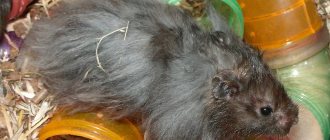- home
- General information
18.07.2018
Unfortunately, tumors in hamsters are not uncommon. This is especially true for animals over two years of age. If you find a lump on your pet's neck, belly, back, side or paw, try to find out the cause. The lump may be hard or soft, painless or painful when touched. In any case, the baby needs urgent treatment.
Determination methods
There are several methods to determine the sex of a Djungarian hamster
The sex of a hamster can be determined when the animal reaches three to four weeks of age. If the hamster is already an adult, there should be no problems with sex determination. But if puberty has not yet occurred, it is worth trying the following methods.
First you need to secure the hamster. two ways to do this .
- We need the hamster to spread its hind legs and let us see its genitals. To do this, with clean hands, carefully grab it by the scruff of the neck and lift it, the hamster will stretch out, and it will be easier to establish its sex.
- The second method is much preferable because it causes less anxiety and discomfort to the animal. So, you can place the hamster on your palm with its belly up and hold it with your thumb. Under no circumstances should you squeeze the body of your cute rodent too tightly; you need to handle it very carefully, identifying the animal’s sexual characteristics with your free hand. Stroke the hamster's belly a little to calm it down, caress it, because with caress you can achieve much more from an animal. And the pet will know that you can be trusted and you will not harm him.
Determined by external signs
- There is another way to find out the gender of your furry pet - this is your careful observation of your pets. Female “jungarians” are usually more active, but they are reluctant to be handled and may even bite. And males, according to observations, are kinder and more phlegmatic.
- Another common way to determine the sex of a “jungarik” by external signs is the longer and thicker hair of males.
Now you are familiar with simple ways to determine the sex of a Djungarian hamster and now you can do it yourself.
Video: how to choose the right one?
You need to know the sex of a hamster at least in order to regulate the process of its reproduction. Because any animal in a pair lives much longer than alone, even if it is two or three years, which is how long is measured for the Djungarian hamster. And same-sex hamsters very rarely get along in the same cage. And, of course, you need to know the gender of the hamster in order to give the pet a name that matches both its gender and its character - it will be called Pirate or Gourmand.
tvoipitomec.info
Treatment and prevention of tumors in hamsters
Excluding high-calorie and nitrate-rich foods from the diet of rodents is the main prevention of the development of all kinds of tumors in hamsters. Broccoli, cauliflower and carrots are excellent contributors to preventive nutrition in rodents.
If your pet does not experience pain or any discomfort, the tumor should be left without surgical treatment. After the tumor appears, animals can live for quite a long time. Before visiting a doctor, you should make sure that it is the neoplasm that is present, and not the sexual characteristics or scent glands of the rodent.
The presence of inflamed lymph nodes or abscesses will require treatment with antibiotics, external agents (ointments), viral drugs and, most recently, surgery.
Purulent formations or an abscess are opened, then the wounds are disinfected, the edges of the wounds are treated with brilliant green, and the wound itself is treated with peroxide and any medicinal antiseptic ointment is applied (levomekol, phytoelite). If, without waiting for surgical intervention, the tumor ruptures (bursts), the place where the animal lives should be immediately disinfected with a special solution.
If you value your pet, do not self-medicate under any circumstances; urgently contact a veterinarian if he is not available.
The specialist will examine the hamster patient, take all the necessary tests if necessary, make a diagnosis and prescribe treatment.
If redness, wounds or any skin lumps appear, apathy, loss of appetite, poor coordination of movements or any bleeding, you will need to see a doctor immediately!
Surgical intervention
If a tumor is detected in your pet, you must take a risk and agree to surgical removal. The formations in rodents grow rapidly, the skin cannot withstand it and bursts, forming a fetid, non-healing ulcer. The tumor mass prevents the animal from moving; sometimes the hamsters themselves try to chew off the foreign tissue and die from blood loss. If a limb is affected by cancer, amputation is the best option. If the tumor is on the body, it must be removed while it is still small, otherwise it will be difficult for the surgeon to close the skin defect after removal.
The use of inhalation anesthesia in recent years has increased the survival rate of rodents after surgery. The doctor must have experience working with rodents and ensure that the tiny organism does not become hypothermic during anesthesia. A starvation diet before surgery is not prescribed, and is even harmful.
Removing the tumor itself will not cure the hamster; it will remain sick and may die from tumor metastases to other organs (lungs, liver). But it can improve the quality of life.
If internal organs are affected by cancer, one can only guess about this by the symptoms or asymmetry of the abdomen. In this case, the operation does not make sense and the operation comes down to euthanasia on the surgical table.
Dzungariki, how to distinguish a boy from a girl - visually
To determine whether it is female or male, the pet must be turned over on its back and, carefully holding the head and paws with a finger, examine the rodent’s tummy.
There are three distinctive features that determine the sex of a hamster.
- On the male's tummy you can feel a small bump resembling a navel.
- A female hamster is distinguished from a male by the presence of nipples.
- The distance between the anus and genitals in males is approximately 1.5 cm, in girls - several millimeters.
Digestive diseases in hamsters
Obesity in hamsters
Obesity in a hamster - an increase in the amount of subcutaneous fat in a hamster can have a bad effect on other organs, such as the heart. By nature, the hamster is a mobile animal and needs constant exercise.
- reasons - a decrease in physical activity, often due to the fault of the owner, when living conditions do not meet the requirements;
- symptoms - a visual increase in the fat layer in the hamster. Decreased overall activity
- treatment - increasing the load, installing various treadmills and attractions in the cage. Monitoring caloric intake.
Colibacillosis. Hamster diseases
Colibacillosis in a hamster is a disease of the gastrointestinal tract, which manifests itself in its disorder. Also, this disease is called “wet tail”. It has a bacterial origin. This intestinal pathology can mislead owners, since in the early stages it is similar to other diseases that are not of a bacterial nature.
- reasons - the presence of unfavorable bacteria in the body, which come from food or water;
- symptoms - the main sign is the presence of diarrhea in a hamster. Subsequently, lack of appetite, water diarrhea, aggressive conditions, bleeding are connected;
- treatment - colibacillosis can be cured only by following all the instructions and recommendations of a veterinarian. Most often, solutions containing electrolytes are used to improve the hydration process. Along with this, antibiotics are prescribed that stabilize the condition of the intestines. It is also necessary to adhere to a certain diet, which involves excluding certain foods from the diet.
Important! Colibacillosis can be transmitted to other individuals. Therefore, if you have other hamsters, they must be isolated from the infected pet.
Enteritis in a hamster
Enteritis in hamsters affects the organs responsible for normal digestion of the animal.
- reasons - doctors call the main factor in the development of enteritis, the lack of hay in the diet;
- symptoms: bloating and diarrhea;
- treatment looks specific. The feces of a healthy animal are taken, mixed in water and administered as an enema to the patient. It is also recommended to include hay in the diet to improve digestion.
Poisoning - diseases of hamsters
- reasons: poor quality of food consumed, presence of household chemicals on food products. Dirty or stagnant water;
- symptoms: loss of appetite, lethargy. Sometimes diarrhea and vomiting;
- treatment - a veterinarian should prescribe treatment based on the results of the examinations. It is important to distinguish poisoning from a viral infection. Failure to seek help in a timely manner can result in death.
How to determine the sex of a Djungarian hamster: photos of a step-by-step examination
Many buyers do not think about how to find out the gender of a Djungarian hamster and purchase the animal “blindly”, guided by the criteria “This one is very cute” or “This one is the most active, it suits me.” Most of these inexperienced breeders then have problems with breeding and keeping these animals.
Hamsters are fairly unpretentious pets. They are cute, fluffy and funny. In addition, they do not require special care and feeding regimen. This is why many people prefer to have hamsters. There are many species of these animals. The most common are dwarf Djungarian hamsters and large Syrian ones. When purchasing a hamster in a store, the seller usually tells you its gender. However, sometimes the seller may make a mistake. If only one individual will live in a cage, then gender, as a rule, does not matter. However, if you plan to have several animals living in the same area, you must find out the gender of the animal you are purchasing. Firstly, so that there are no unwanted offspring, or so that same-sex animals do not fight for territory. It is easier to find out the sex of a hamster if it is an adult. However, there are several ways to find out the gender of any hamster.
You need to start examining the animal right in the store. This will allow you to compare it with other individuals and more accurately identify the result. No need to hurry. First you need to pet the animal and treat it with something tasty. You need to understand whether the hamster will bite your hand during examination. If the animal is friendly, you can begin the inspection. First you need to pay attention to the groin area. In males, especially sexually mature ones, testicles can be easily detected. In a female, if you palpate the tummy, you can find nipples. The female hamster has 3 pairs of nipples. However, these signs appear only in sexually mature individuals.
In small hamsters you need to pay attention to the genitals. If you look closely, you can see the anus under the tail. A little further, towards the stomach, you can see another opening - the urethra. So, in females these holes are very close to each other. In males, at a fairly large distance. If you are not sure, you can compare the individual you are purchasing with others. Such a comparative analysis will help to more likely determine the sex of the hamster.
Even if the hamster is small, testicles begin to form. Therefore, carefully feel the groin area. If swelling is found there, then most likely this is a male.
If you are not 100% sure, then it is better to place the hamster in a separate cage. After a month, the animal’s sexual characteristics will become more pronounced. Then it will be much easier to determine the gender.
There are several tips to help make the examination safe for the animal. Firstly, you should not create a stressful situation for the animal. Remember that hamsters are very shy. If a hamster cannot be examined at a pet store, this should not be done forcibly. Secondly, all palpating should be done carefully and gently. Remember that if the hamster feels painful, it may bite the offender. After examining the animal, be sure to wash your hands with soap.
In fact, there is nothing difficult in identifying the sex of a hamster. The main thing is that the animal is healthy and friendly. Then, regardless of gender, the hamster will fit perfectly into the family.
grumy.ru
Before we talk about scent glands , we should understand the types of hamsters.
At home, they most often contain:
- Syrian hamster; - Campbell's dwarf hamster; - Dzungarian dwarf hamster. The last two types of hamsters are very similar in appearance and even interbreed. But, nevertheless, these are different hamsters.
Questions of the following nature are often asked about the condition of Syrian hamsters: “... the hamster recently developed black sores on its back, symmetrically to each other. What could it be? How dangerous is this for animals and people?”; “... I noticed two black spots on the sides of the hamster’s back, similar to birthmarks. There are large round bald spots around the spots...”; - “... what is the black spot (spots) on the back (on the barrel) of the Syrian hamster and how to treat it?”; - “... our hamster began to itch on the sides, where her hind legs reach, she even developed scabs on both the right and left. It looks like small black dots on some parts of the body...”
What should you know in this case? Syrian hamsters have scent glands on their sides, the secretions of which are used by hamsters to mark territory. The glands are located symmetrically on the sides, slightly in front of the hind legs. This is a normal anatomical formation for Syrian hamsters!
What are the nuances? 1. The appearance of the glands may differ for each individual Syrian. For some they are practically invisible, for others they are pronounced. The glands can be large or small, convex or flat, light or brown. It happens that the glands simply look like a cluster of dark spots on the skin. 2. In males, the glands are more visible. They are large and dark, resembling moles or warts. 3. In females, the glands are not as convex and rough as in males. They are hardly noticeable on the body and (if there is no pigmentation) may not be detected at all. 4. The hamster can (and should) rub its sides (glands) against the bars of the cage when marking its territory. This is not a cause for concern. 5. Wool does not grow on glands. 6. In light-colored short-haired hamsters, the glands are often more visible than in other colors and hair types. 7. In young males of light colors, in place of the glands, the coat may be of a different, brighter color than the main color. 8. Males can “lick the glands” when they mark a new territory, when a female in heat is nearby, or in a state of severe stress. 9. The glands do not need to be “treated.” However, it is important to consider that a change in their appearance or the condition of the hair around them is a sign of severe stress in the hamster (he tries to smell as intensely as possible in order to scare enemies or secure territory). 9. Cases of the development of an inflammatory or oncological process in the glands are often noted. Such situations require conservative or surgical treatment by a veterinarian specializing in the treatment of rodents.
Questions about dwarf hamsters are also often asked:
- “... the dzhungarik has a sore on his stomach, is it dangerous?”; - “...my dzhungarik is itching and some kind of pimple has popped up on his stomach. Please tell me what to do?”; - “... my jungarik (boy) has something appeared right in the middle of his abdomen, it looks like dry skin, or a dry sore (what could it be???"
What is the situation for the "dwarfs". Male dwarf hamsters (both Djungarian and Campbell's hamsters) have a scent gland on their abdomen. This is a natural anatomical formation and there is no need to worry about it. Dwarf hamsters (like Syrians) mark territory (it looks like the hamster is itching or scratching its belly). The gland usually looks like an oval-shaped spot or “crust”, red or brownish in color, often with yellow droplets of secretion.
Females lack iron.
Thus, both Syrian and dwarf hamsters normally have scent glands. There is no need to treat these anatomical formations. However, it is important to keep track of their appearance, as it can reflect both the emotional state and health of the hamster. In addition, sometimes the scent glands become inflamed. Older pets may also develop a tumor of the scent gland. These conditions already require veterinary care (therapy or surgery).
Veterinarian Artem Arkadievich Kazakov
rodentovet.ru
Useful properties and composition of eggs
This is a complete nutritious product, the protein of which is easily absorbed by the body. Therefore, its usefulness for hamsters is obvious. In addition to protein, eggs are rich in proteins, carbohydrates, minerals and vitamins. It is perfect for feeding hamsters.
In addition, eating this product will improve the functioning of the liver and nervous system, prevent cancer, and help your pet feel cheerful and healthy. Pregnant females are assisted in the proper development of the fetus.
Be sure to include a boiled egg in your diet, which consists of white and yolk. Protein contains water (90%), vitamins, glucose, carbohydrates, and various enzymes (10%). The yolk contains organic substances - fats, minerals (iron, calcium, magnesium, potassium, sodium and others) and vitamins (A, D, E and K). This part serves as the only nutritional element for the embryo for normal development and growth. The yolk is most useful as food for rodents. You shouldn't give up protein either.
When purchasing, do not forget to look at the expiration date so that the product is not expired and so as not to poison your pet.
When and how much to give
Excessive consumption of them will have a negative effect on the hamster’s digestive system. Feeding should be moderate. Veterinarians recommend eating a third of chicken or half of quail 1-2 times a week, and this is the maximum. If you are wondering how to give - a whole piece or a small one, then there is no difference. You can whole, cut, grate, even mix with other products: grated carrots or cereal mixture. Cereals can also be replaced with crackers or grains. Try different things and choose what your hamster likes best. If you are discussing how much protein to give and how much yolk, then no more than 2/3 white and 1/3 yolk if you give a chicken egg. You can give half a quail.
Pregnant and lactating females must include this product in their diet.
Product Features
Eggs contain elements that have a beneficial effect on the health and condition of the body. They contain the following components:
- Proteins.
- Squirrels.
- Vitamins of groups A, E, D, K.
- Carbohydrates.
- Minerals (potassium, calcium, magnesium, iron, etc.).
All these components are easily absorbed in the human and animal body. They have beneficial properties and charge you with the necessary energy. Hamsters can be given eggs in moderation.
The egg consists of white and yolk. The first element contains 90% water. The remaining 10% consists of proteins, glucose, vitamins, and enzymes. The yolk consists of organic substances - fats, minerals, vitamins. The yolk is the most useful element. It has a beneficial effect on the growth, health, and development of the hamster. It is recommended to feed the animal with both components.
Do not doubt whether hamsters can have a boiled egg. As a supplement to food, it is necessary.
The product helps strengthen bones, normalize the functioning of the liver and digestive organs. Has a beneficial effect on the nervous system and the course of pregnancy. Helps prevent the development of tumors.
Black spots on the sides or scent glands in Syrian hamsters
Some types of hamsters (Syrian, in particular) have special scent glands on their sides. Rodents need them to mark their territory. Their location is symmetrical on the sides; they can also be located slightly in front of the hind legs of rodents. These glands look like small black dots. When the hamster's color is light, by parting the pet's fur in these places, you can easily notice such scent glands. In hamsters with dark fur, they are more difficult to notice.
The presence of glands was thought out by Mother Nature, so there is no need to worry about finding them on your pet’s body. These are not symptoms of some terrible disease, but an anatomical feature of these creatures.
How to properly restrain an animal for inspection
It is easy to determine the sex of an adult representative of the breed, because his external sexual characteristics are clearly expressed and visible during examination. But if you need to find out the sex of the cub, you should wait until it is 3-4 weeks old. It is from this age that it becomes possible to understand whether it is a boy or a girl.
To begin with, the pet needs to be placed in such a way that the external sexual characteristics become visible. There are two ways to do this:
1. In order for the rodent to show its genitals, you need to grab it by the scruff of the neck with your hand and lift it up. Thus, the body is stretched, and the areas that need to be examined become clearly visible.
2. Another method is not as stressful for the animal as the previous one. The baby should be placed on the palm of his hand with his belly up, while carefully holding him with his thumb. It is possible that at first he will not really like this position, but the animal can be calmed by gently stroking its tummy. In this case, it becomes possible to examine the area of interest of the body.
In order to find out the gender of this cute pet, you need to carefully examine it. Naturally, the main characteristics of both the female and the male are the genitals. Additionally, the size of the rodent’s body, as well as its character, can tell whether an animal is female or male.
How to identify a male hamster
- In a male Djungarian hamster, starting from the age of four weeks, you can already notice the testicles, which are located near the base of the tail. Having placed the animal on your palm with its tummy up, you need to very carefully press on the abdomen so that the testicles become visible. The distance between the penis and the anus in adult representatives of the breed should be from 1 to 1.5 cm, and in babies approximately 0.5 cm.
- In males, the navel can be easily felt. It is with its help that these animals mark their territory.
- If, when examining an adult pet, you can see a slightly pointed edge of the back, it means the pet is male, and when this area is more rounded, it is female.
- If the cubs of these animals feel swelling in the groin area, it is the testicles that are maturing and, accordingly, these babies are male.
- Males have thicker fur than females.
How to identify a female hamster
- In females, the distance from the genitals to the anus is approximately 3 mm.
- In girls of this species of animals, two rows of nipples stretch on the abdomen all the way to the chest. There are eight of them. The navel cannot be felt.
- Girls of Djungarian hamsters are usually larger than boys, so by raising several pets of this breed at home, in most cases you can correctly determine their sex by body size.
- Females are much more active than males, they do not like to be handled, and sometimes, in protest, they can bite a finger.
Localization of neoplasms
A neoplasm on a hamster's body can appear anywhere. Very often the tumor occurs in the neck, abdomen, legs, and lateral areas. The hamster is also susceptible. You definitely don't have a carabash.
To prevent the appearance of these formations, you need to frequently inspect the hamster's body. If oncological formations are almost impossible to recognize in the early stages, then benign tumors can be easily identified independently.
It is important to understand that hamsters are small rodents. It is very difficult to fight viruses that quickly spread throughout the hamster’s body. Aggressive external factors only contribute to the progression of diseases. In the final stages of the disease, it is very difficult to prevent the spread of infection.
Neoplasm on the neck
A tumor in a hamster's neck is most often a benign tumor. The manifestation of this tumor is associated with inflammation of the lymph nodes. Her treatment is a rather complex process. The pet may become aggressive and may be difficult to calm down. The hamster may refuse to eat and simply sleep in its cage. If the tumor is not removed, it will grow, which will not only lead to death, but will also cause a lot of inconvenience to the pet during life.
The animal’s body will try to cope with the disease on its own, but in the process of fighting the inflammatory process will only grow, which will lead to the formation of pus in the lesion. An abscess will cause your pet a lot of pain, which will provoke even greater aggression and a complete lack of appetite.
The tumor can lead the animal to exhaustion.
Lump on cheek
A lump on your pet's cheek is a sign of clogged cheek pouches. They can become clogged with particles of low-quality food. It is impossible to cope with this tumor using only medications. You need to contact a veterinarian to clean the bags and disinfect them. Inflammation on the cheek must be treated with an antibiotic.
To eliminate the risk of tumor formation on the cheek, you need to carefully select food for your pet. It should not be hard or too soft.
Sometimes you can still make a mistake by confusing buccal compaction with malocclusion. Mallucclusion is a lump-shaped lump under the eye. You can also recognize it by the way your teeth wear down. If it’s bad, then it’s definitely not the food.
Neoplasms under the tail
It happens that a hamster's testicles enlarge during puberty. In such situations, the owner begins to seriously worry about the health of the pet. Large rodent testicles are not always a sign of cancer. Typically, an animal's testicles become large due to the accumulation of seminal fluid. All you need to do is find a female.
If the testicles still remain large for a long time, turn red and become warm to the touch, then you should consult a doctor. Most likely, the hamster has developed oncology. Only castration will help here. If the doctor diagnoses “inflammation of the testicles,” then antibiotics must be added to the animal’s food.
Lump on the side of the body
These growths are a sign that the hamster has most likely been injured. In any case, it is very difficult to determine the nature of tumors on the side on your own. In such situations, only an experienced doctor - a ratologist - will help. A tumor on a hamster's side is a serious reason to contact a veterinarian. He will tell you what to do in such a situation.
Lumps on the abdomen
Sometimes you can see a tumor on the abdomen of hamsters. Such tumors can be observed in females in the mammary gland area. It can be either benign or malignant. Such neoplasms do not form inside the hamster, but only on the mammary glands. For this reason, they are easy to remove if necessary.
If the tumor appears in a male, then most likely it is inflammation of the marker glands. This gland is easy to identify once you know the physiology of the hamster. For example, in Djungarian hamsters the color of this gland is yellow. Syrian hamsters have two such glands. They are located symmetrically on the sides of both legs of hamsters. Such neoplasms are gray in color and oval in shape.
In any case, there is no need to be afraid. This is not a tumor, this is a structural feature of the male hamster’s body.
Tumors of Djungarian hamsters in the early stages can be easily detected by the behavior of the pet or by its external signs. If an animal quickly loses weight, moves little or does not drink at all, then this is the first sign of tumor formation. Very often, hamsters' fur looks disheveled, greasy, or may even fall out in clumps at the site of the neoplasm. Also, when the owner notices:
- unpleasant odor from the animal;
- stool disorders;
- sudden skin redness;
- “glued” eyes or completely protruding;
- strange discharge from the mouth, genitals;
- skeletal curvatures;
- weight loss,
You need to contact a veterinarian. Such symptoms are a sign that the formation of a malignant tumor is possible. If inflammatory processes are not prevented in time, the pet will die.
Illnesses occur in hamsters even when proper care is taken. Even an accidental draft can cause inflammation.
There may be congenital pathologies that do not appear outwardly, but make themselves felt only during growing up. It is important to monitor the condition of your hamster's entertainment equipment. If the hamster accidentally injures itself, this will also lead to problems with its health.
Other neoplasms
You can often see that a hamster has a swollen paw. A tumor on a hamster's paw is a serious problem. You should definitely contact a veterinarian. But not only bruises can cause tumors; very often animals suffer from osteosarcoma and dangerous viral diseases. Infection of tissues with viruses leads to the proliferation of bone tissue and enlargement of limbs. The inflammatory process leads to the growth of the lesion. Often the inflammation spreads to the trunk area. Viral diseases cannot be treated, so death is inevitable.
It is necessary to periodically replace the animal's bedding, since particles of shavings that are too small can stick into the paw and damage the internal tissues of the animal.
Another disease caused by viruses is called papilloma. Due to infection with viruses, the tissue begins to increase in size. Such formations begin as small bumps, then become wart-like. If such formations are not removed, they can grow up to 2 cm. For a person this is an insignificant size, but for a small hamster these warts are significant.
Dzungariki, how to distinguish a boy from a girl - other signs
By the behavior of sexually mature individuals, it is also possible to determine the gender of Djungarian hamsters. Females are more aggressive in the company of their own kind, males, but the hair of Djungarian boys is longer than that of their female friends.
Hamsters are small, playful animals that are easy and pleasant to keep in the house, and a very small space will be enough. Caring for them is easy, and even a child can be trusted with it. When buying this animal, even sellers sometimes cannot answer the question of how to determine the sex of a hamster.
Who are hamsters?
The hamster family includes small rodents with short legs and a small tail. The body is tightly folded, its length can be from 5 to 34 cm. They have special cheek pouches that are designed for carrying food, giving these animals a special charm. In nature, they live in the steppe regions of Europe and Asia; they can be found even at an altitude of 3600 m. These animals are often found near human homes, in gardens and vegetable gardens, where they are pests.
Types of hamsters
There are 7 genera and 19 species in the hamster family. Among them there are specimens of different colors and coat lengths. Most often, near human habitation you can find one that can turn out to be a serious opponent and leave deep marks from its teeth, because its size is comparable to a rat. And houses most often contain varieties such as medium-sized hamsters (usually Syrian) and small Djungarian hamsters, which look like fluffy gray mice.
Pet hamsters
Due to their playful nature and cheerful disposition, some of them are kept in captivity at home. These are mainly Syrian Campbell and Roborovsky. When buying such an animal, you need to decide what size animal you want to have, and it is advisable to find out how to find out the gender of the hamster. You also need to take into account that almost all hamsters are solitary in their lifestyle. Therefore, if you try to keep them together, fights and other troubles may arise. Even when the animals are of different sexes.
Syrian hamsters have a particularly wide variety of coat colors and shapes. It is among them that you can find rodents with long fur, which are sometimes called “Angora”. These furry babies look especially interesting, but the problem always arises of how to determine the gender of a hamster with such a fur coat. Often they also pay attention to small ones. They require very little space to maintain, but will please the eye, cheerfully rustling in the sawdust or running intently in a wheel. As a result of breeding and selection, even curly hamsters have been bred.
How to determine the sex of a hamster?
This is important if several animals are purchased for further reproduction (we remind you once again that they must be kept separately), and, of course, when choosing a name for a pet. The main difference between males and females is the different distance between the genitals and the anus. For girls, these two holes are located close, at a distance of about 3 mm, and for boys - much further, at 1.5 cm. Before determining the gender of the hamster, it is most convenient to carefully grab it by the scruff of the neck. At the same time, the animal will instinctively stretch out and spread its hind legs. However, if the question is how to determine the sex of a baby Djungarian hamster, it is better to act differently. You should place the animal on its back in your palm, holding the upper part of its body with your thumb. Then the genitals will be clearly visible.
Determining the sex of a hamster is not a difficult task, but when purchasing, it is better to study the animal yourself rather than rely entirely on the seller.
Djungarian hamsters can become wonderful friends for both children and adults. These funny, clean little animals are most often adopted by those who do not yet have experience keeping pets at home. Even children can cope with them. This is precisely the reason why animals of this species are often purchased as a gift for a child.
Often when buying an animal, people do not think about whether they chose a boy or a girl. But if the purpose of purchasing a rodent is to further breed hamsters, or if you already have a hamster at home, it is important to learn to distinguish between males and females by gender.
Tumors on the hamster's body
Neoplasms, or as they are also called, tumors in hamsters are different in appearance and character. First of all, tumors are divided into two types:
- benign;
- malignant.
Malignant formations are cells of a rodent’s body that have degenerated; they grow quite quickly. To our great regret, these are cancerous formations that most often penetrate various tissues located nearby or nearby. Today, medicine, including human medicine, cannot defeat such neoplasms, since their symptoms in hamsters appear quite late. When a diagnosis and verdict of “cancer” is established, it is better to euthanize the animal.
Benign – occur as a result of injuries, inflammatory processes, malfunctions in the animal’s body itself, or improper nutrition. If you lightly press on the tumor, it moves easily under the skin of the animal. Such neoplasms do not adhere tightly to the tissues, which makes it possible to remove them surgically without causing the animal much inconvenience or pain. In their structure, such tumors are hard, soft, or cartilage-like.
The main reason for the occurrence of tumors in furry little animals is the fact that their immune system cannot cope with the harmful cell, which after some time will turn into a tumor. Secondary reasons for the appearance of all kinds of tumors in domestic animals are disruptions in the immune system, hormonal disruptions, or injuries.
Tumor on the abdomen
Have you found a tumor on your hamster's stomach, groin or armpits? Such tumors are most often benign. In 94% of cases, a tumor on the tummy of a hamster is a tumor of the mammary glands. Such formations are most likely benign, but it is still worth removing them so that in the future they do not degenerate into malignant ones. In this case, ointments and compresses are ineffective.
Lump on the neck
A tumor in a hamster’s neck is most often an inflammation of the lymph nodes. Inflammation of the nodes can cause anxiety to the rodent, the pet becomes somewhat aggressive and behaves in an unnatural way. In some cases, a mass on the neck may not cause any discomfort to the hamster or affect its life in any way.
Most often, these bumps feel hard to the touch. The lymphatic system, by its nature, performs the body’s protective function against all kinds of microbes. Enlarged lymph nodes mean that an infection has entered the rodent’s body. When a rodent's body fights foci of infection, an inflammatory process occurs. A complex form of inflammation develops into an abscess and suppuration. With an abscess, the touch gives the hamster an unpleasant and painful sensation, the skin is inflamed, and the hardened lump becomes soft and suppuration appears.
Tumor on the cheek
A tumor has formed on the hamster's cheek - this may be a blockage of the cheek pouches due to food that is completely unsuitable for your rodent. To eliminate the problem, contact a veterinary clinic, where the animal will be cleaned, disinfected, and your pet’s cheeks will be treated with antibiotic drugs, and within a day he will be healthy.
Tumor on the butt
A tumor on the hamster’s butt may mean that your hamster is a boy and has a large “masculine” virtue – testicles. If you have a female hamster, you should contact a knowledgeable specialist to determine the cause of incomprehensible formations.
Education on the side
Why a tumor appears on the side of a hamster without examination by a veterinarian is quite difficult. Perhaps your pet was injured - he fell from a height, or you gave him food that is not suitable for him. All these questions will be answered by a professional rodent specialist – ratologist.
Why be able to distinguish hamsters by gender?
Anyone who plans to acquire a small ornamental animal should understand that distinguishing between females and males is as important as knowing how to choose the right cage for it, etc.
Why is it important to determine the sex of these rodents? There are several answers to this question.
Firstly
, a male and a female are specially purchased if they want to breed rodents at home. In this case, future breeders simply need to know how to distinguish Djungarian hamsters by sex, so as not to acquire two same-sex animals. In addition to the fact that such a couple will not produce offspring, they can also seriously mutilate each other. This is especially true for adult representatives of the breed staying in the same cage. Their nature is as follows: they do not put up with competitors on their territory.
Secondly
, sometimes a store clerk or a novice breeder from whom you can buy an ornamental rodent does not know how to determine the sex of the animal. In this case, the buyer must learn to independently distinguish females from males of this breed in order to choose a suitable animal for himself.
Third
, sometimes a person wants to have a boy or a girl Djungarian hamster. Anyone who wants to have a male animal needs to be especially careful when purchasing. After all, there are cases when a female is sold to an inexperienced buyer, and at that time she may already be pregnant. Such an acquisition will not please a person who planned to keep one animal, but instead acquired a large family of rodents.
Fourth
, in order to choose a name for your pet. After all, if you don’t know who he is (a boy or a girl), then what should you call him?
Skin diseases
Hamsters are susceptible to fungal skin diseases. Then various sores appear on the paws, ears, stomach and other parts of the animal’s body. There is also itching and dandruff.
The following fungal diseases are more often diagnosed in hamsters:
- Dermatophytosis is caused by fungi of the genus Trichophyton and Microsporum. The skin peels off, ulcers appear on the affected area, a grayish coating appears, and hair falls out. Due to itching, the hamster scratches the sore spot, which increases the risk of secondary infection. The disease must be treated with special solutions (Chlorhexidine, Miramistin), ointments, shampoos, which will be prescribed by the doctor.
- Scab is caused by achorions (fungi). You can tell that a hamster is sick by the following symptoms: loose areas of peeling in the eye area, as well as in the hamster’s ear, gray small blisters that turn into crusts and ulcers. Itching and scratching are also present.
- Skin damage by ectoparasites (fleas, lice eaters, ticks). Pet rodents can become ill through contact with infected animals. They can be seen with the naked eye when examining the animal’s body. Most often, parasites live on the skin of the body, but sometimes they infect the ear from the inside. In the latter case, the animal violently shakes its head. This is how a tick infestation manifests itself. Hamsters should be treated with contact insecticides in a safe dosage.
In addition to fungicidal, antibacterial drugs, antiseptic solutions, antiparasitic shampoos, vitamins for hamsters complement the treatment. The latest remedies will help strengthen the animal’s immunity and speed up recovery.
Recommendations
When determining the sex of a Syrian hamster, it is important to adhere to certain rules:
- It should be borne in mind that an examination is a lot of stress for an animal. You should wait until the animal calms down, and then carefully pick it up.
- Remember to wash your hands before handling the animal. If the fingers smell like food, the animal may bite, mistaking them for a tasty treat.
- You cannot use force or shout at the Syrian hamster. He will be afraid and avoid contact with the person. You should talk to the animal in a soft, calm voice.
- If the pet is agitated and trying to escape, there is no need to hold the animal against its will. We need to return it to the cage and wait until it calms down.
- During the inspection, you need to monitor the position of the animal; you cannot turn it upside down. Having lost its balance, the frightened animal will immediately grab its owner with its teeth.
- You need to be prepared for the fact that the furry animal may escape. Therefore, it is advisable to perform the inspection on your knees, or spread something soft underneath. For a hamster, falling even from a small height can cause injury.
- After the procedure, you need to pet and praise your pet, place it in a cage and feed it.
If you are unable to independently determine the sex of your Syrian hamster, you need to contact a ratologist. Upon examination, he can easily determine the gender of the animal.
Determining the sex of a Syrian hamster is not difficult if you know what to look for. A pet is unlikely to be delighted if you take his hands and examine his body for a long time. Therefore, you first need to familiarize yourself with the rules and recommendations, and then feel free to proceed to determine the sex of the furry animal.
Abscess in a hamster
As a result of fights or other injuries, purulent inflammation may occur, which looks like a limited swelling. The lump on the side may well be an abscess rather than cancer. At first it is hard and painful, and the skin is red and hot to the touch. Then the tumor softens and fluctuation appears. Hair may fall out. At the final stage, the abscess spontaneously opens and a wound appears from which pus flows.
For an abscess in a hamster, treatment involves the use of systemic antibiotics (Baytril 2.5% subcutaneously 10 mg/kg body weight). Surgical treatment of the wound is necessary: opening the abscess, cleaning the cavity and washing with an antiseptic. The wound is washed every day and protected from re-infection.
If the abscess is not treated properly, the process becomes chronic and a fistula appears, which will be difficult to heal.
What can hamsters get sick with?
The most common diseases include the following:
- dental growth abnormalities;
- inflammation of the cheek pouches;
- herpes;
- trichomoniasis.
Tooth growth abnormalities
Dental disease is associated with the constant growth of the front teeth (incisors). When they grow too much, the bite is disrupted and the jaws do not close. Too long incisors scratch the oral mucosa, which causes pain. This is often caused by a lack of solid food in the rodent's menu. In this case, the animal does not have time to grind down its incisors.
Interesting! Accelerated tooth growth can be inherited.
Dental diseases lead to an inflammatory process. Abscesses and abscesses often form on the affected area.
Dental diseases in hamsters are manifested by the following symptoms:
- redness of the mucous membranes of the mouth;
- hypersalivation (increased salivation);
- refusal of food;
- weight loss;
- deformation of the front teeth;
- damage to the inside of the cheeks.
As the incisors grow, the hamster chatters its teeth, begins to gnaw at the bars of the cage, and may even bite the owner. He becomes restless due to discomfort and pain.
Overgrown incisors should be shortened using side cutters or a drill. With an incorrect bite, sharp formations form on the teeth that need to be removed. Only a ratologist can carry out such a procedure. It is prohibited to do this on your own.
Inflammation of the cheek pouches
This is one of the most common diseases, which is characterized by inflammation, eversion or prolapse of the cheek pouches. Pathology can lead to the appearance of tumors on the inside of the cheek.
The cheek pouches become inflamed when they are damaged by a sharp object. The likelihood of an inflammatory process increases when they are constantly filled with food (especially roughage).
Then the sick hamster behaves restlessly, refuses food, and drools increased. The animal rubs its cheeks with its paws because of the painful sensations. Sometimes there are no clinical signs of this disease.
To cure your hamster, you need to go to a veterinary clinic.
Important! You should not try to clean the cheek pouches yourself. They need to be turned out carefully and correctly. Improper actions can cause pain to the hamster or further damage the mucous membrane.
To get rid of inflammation, you need to clean the bags of food debris. After this, the oral cavity is washed with an antiseptic, which will stop the development of pathogenic bacteria and also accelerate their death. Probiotics and enzyme-based medications prescribed by your doctor will help normalize digestion.
Herpes
Herpetic infection in hamsters is common. The disease is usually asymptomatic. An animal can become infected from sick animals with which it has been in contact.
Important! The animal can infect its owner with herpes.
In most cases, the disease goes away on its own within 5–10 days. The hamster does not require treatment. But a person needs to see a therapist who will prescribe immunomodulators to increase the body’s protective properties.
Trichomoniasis
This disease is caused by the parasite Trichomonas gallinae. They enter the hamster's body, where they begin to reproduce by fission.
The causes of infection are consumption of contaminated water or feed.
Important! Trichomoniasis most often affects young hamsters, whose immunity is at the stage of formation. In adults, the infection is diagnosed less frequently.
Symptoms of this parasitic disease in hamsters are:
- the pharynx becomes covered with a yellowish coating;
- throat tissues swell;
- difficulty eating;
- breathing is impaired.
If treatment is not carried out in time, the animal will begin to eat little, its weight will decrease, and soon it will die from suffocation.
Sometimes trichomoniasis leads to the appearance of necrotic ulcers in the mouth, pharynx, and also on the upper part of the esophagus. Due to severe damage, the hamster cannot swallow food normally.
To treat the animal, antiparasitic drugs are used, which will be prescribed by a veterinarian. He will advise you on the dosage, frequency, and duration of medication use.
To prevent disease, you need to periodically disinfect the hamster's cage, dishes and other accessories. It is also worth paying attention to the purity of water and the quality of food for the animal.
At what age is gender determined?
The older the dzhungarik becomes, the easier it is to understand who is in front of you - a male or a female. A sexually mature Djungarian hamster is an excellent object for studying reproductive organs, which does not create problems for a potential owner.
Difficulties arise with babies who are less than 4 weeks old (at this tender age, it is generally not recommended to palpate or pick them up).
If you urgently need to figure out the sex of the cubs (you came to the store, but the consultant cannot tell you), follow these steps:
- Gently place the dwarf in your palm, holding it with your thumb so that the back of its body hangs freely. If necessary, lightly hold the hamster from below.
- In this position, the external genitalia of the rodent will become visible to you (if it is worried and tries to slip out, there will be no point in examining it).
- You should be interested in the gap between the anus and urethra. If you have an "assistant", ask him to photograph this area and release the hamster.
Beginning owners, when determining the sex of dzhungarikas, make a common mistake - they take them by the scruff of the neck and lift them so that they spread their paws. Experienced hamster breeders consider this unacceptable.
There is another way to take a closer look at the reproductive organs of the Djungarian hamster. It is placed on the palm with the stomach up, slightly holding it with the thumb. If your pet starts to fidget, try to calm him down by petting his belly. When the rodent relaxes, begin a visual inspection.
What if we have a golden or striped hamster in front of us?
Signs of a male
In four-week-old males, the testicles are already visible at the very base of the tail. Stroke the animal so that it relaxes and does not struggle, and lightly press on the abdomen so that the testes (testicles) become visible. But the most important thing is distance. The distance from the penis to the anus in adult males is from 1 to 1.5 cm. And in babies it’s about 0.5 cm.
Also, in males, the navel is usually clearly palpable in the center of the abdomen - this is a gland characteristic of hamsters, with the help of which they mark their territory. It feels like a small growth.
Sometimes male Djungarian hamsters have a small congenital defect: the gonads do not descend into the scrotum, but remain in the abdominal cavity, in this case it is clear that the urethra and anus are located at a slight distance from each other.
In Djungarian babies, you can tactilely detect small swellings in the groin - these are maturing testicles.
Signs of a female
Assess the size of your pet compared to others: usually females are larger than males. But if there are no other hamsters nearby, it is worth trying a more accurate method. In “jungarian” females, the distance between the genitals and the anus is much smaller than in males : approximately 3 mm, almost close.
Also, the female can be identified by two rows of tiny nipples that stretch from the chest to the bottom of the abdomen - there are usually eight of them, each intended for the planned calf. But the navel of females, unlike males, is almost invisible. In front of you is a female, and if upon examination you see one hole, but a large one, there may be two of them, but due to the too small size and small age of the animal, they visually merge into one.
Video: gender determination
Scent glands in dwarf Djungarian and dwarf Campbell's hamsters
Due to the anatomical features of dwarf Djungarian and Campbell's dwarf hamsters (more about the types of hamsters), their scent glands are located on the stomach, and not on the sides. Otherwise they look the same as those of Syrian hamsters. It’s just that, in order to mark the territory, the Dzungariki rub their bellies against the floor of the cage, while the Syrians would rub their sides against its bars.
The gland itself has an oval or round spot, brownish or red in color, from which a small amount of yellow secretion can be released.
But female dwarf Djungarian and dwarf Campbell's hamsters do not have scent glands at all.
If we have a dwarf breed in front of us
You can see small white spots on the Dzungarian's fur coat, because the Djungarian (or Dzungarian) hamster is a steppe animal; in natural conditions it is often forced to hide from predators by burying itself in the snow. The Djungarian's face is simply touching: big intelligent eyes, ears that twitch warily, listening to all the sounds around him, funny moving cheeks.
He himself is all round, the natural color of these animals is dark gray, with a light belly, a darkish spot on the top of the head and a stripe on the back. There are pearl and blue jungarians.











